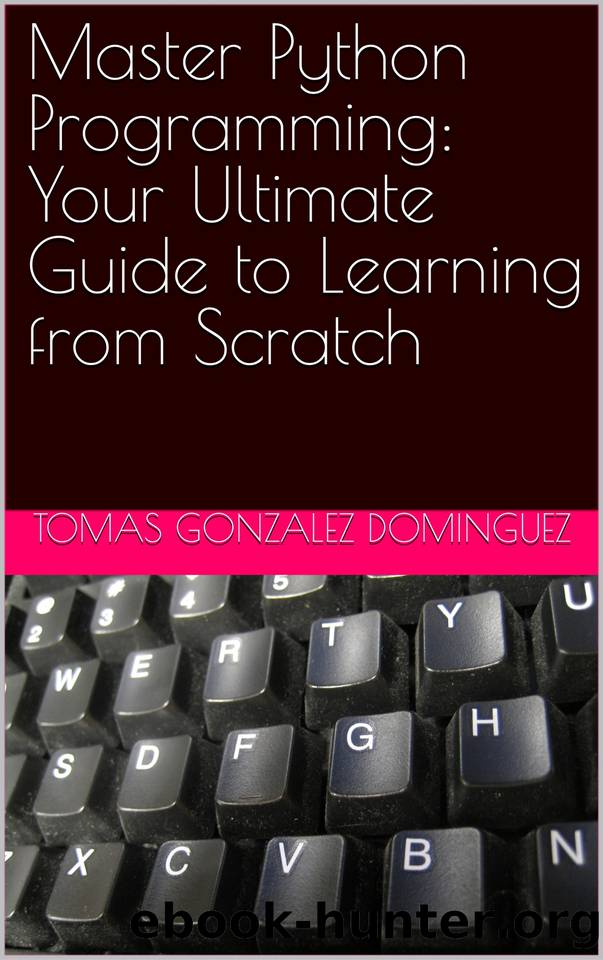Master Python Programming: Your Ultimate Guide to Learning from Scratch by Gonzalez Dominguez Tomas

Author:Gonzalez Dominguez, Tomas
Language: eng
Format: epub
Published: 2024-02-12T00:00:00+00:00
Classes and objects
Python is an object-oriented programming language, meaning it allows users to define structures known as classes, which can model the real world intuitively and flexibly. Classes act as templates for creating objects, which are instances of these classes. Each object can have attributes (also known as properties) to maintain its state and methods (functions) to modify that state or perform operations. This article explores the fundamental concepts of classes and objects in Python, providing a solid foundation for understanding object-oriented programming (OOP) in this language.
Definition of Classes
A class is defined in Python using the `class` keyword, followed by the class name and a colon. The body of the class contains method definitions (which are functions associated with the class).
class MiClase:
def __init__(self, attribute):
self.attribute = attribute
def my_method(self):
print(f"Attribute value is {self.attribute}")
The `__init__` method is a special constructor that is called automatically when a new object of that class is created. It is used to initialize the attributes of the object. The first parameter of each method, `self`, is a reference to the current object and is used to access the object's attributes and methods.
Object Creation
To create an object (or instance) of a class, simply call the class as if it were a function, passing the arguments that the `__init__` method expects.
my_object = MyClass("value")
my_object.my_method() # Output: The attribute value is value
Attributes and Methods
Attributes are variables that belong to an object or class, and methods are functions that operate on the object or class.
- Instance attributes: They are unique for each object, defined within the `__init__` method or in any other method with `self.attribute_name`.
- Class attributes: They are shared by all instances of a class. They are defined outside any method and are accessed using the class name.
class MiClase:
class_attribute = "shared"
def __init__(self, instance_attribute):
self.instance_attribute = instance_attribute
- Instance methods: They operate on an instance of the class and have access to the `self` object.
- Class methods: They operate on the class itself and not on particular instances. They are defined with the `@classmethod` decorator and accept `cls` as the first parameter.
- Static methods: They do not operate on the class or on instances of the class and do not have special parameters such as `self` or `cls`. They are defined with the `@staticmethod` decorator.
Inheritance
Inheritance allows a class to inherit attributes and methods from another class. The base class (or superclass) provides attributes and methods to the derived class (or subclass).
class Base:
def base_metodo(self):
print("Base class method")
class Derived(Base):
def derived_method(self):
print("Derived class method")
Polymorphism
Polymorphism is the ability to use common interfaces for different types. In Python, this means that different classes can have methods with the same name, but different implementations.
Conclusion
Classes and objects are fundamental to object-oriented programming in Python, allowing developers to create reusable, organized, and easy-to-maintain code. Understanding how to define classes, create objects, and use inheritance and polymorphism are crucial steps to harnessing the full power of Python and writing efficient and effective programs.
Download
This site does not store any files on its server. We only index and link to content provided by other sites. Please contact the content providers to delete copyright contents if any and email us, we'll remove relevant links or contents immediately.
Deep Learning with Python by François Chollet(12953)
Hello! Python by Anthony Briggs(10193)
The Mikado Method by Ola Ellnestam Daniel Brolund(10106)
OCA Java SE 8 Programmer I Certification Guide by Mala Gupta(10041)
Dependency Injection in .NET by Mark Seemann(9580)
Algorithms of the Intelligent Web by Haralambos Marmanis;Dmitry Babenko(8585)
Grails in Action by Glen Smith Peter Ledbrook(7940)
Test-Driven iOS Development with Swift 4 by Dominik Hauser(7898)
Becoming a Dynamics 365 Finance and Supply Chain Solution Architect by Brent Dawson(7879)
The Well-Grounded Java Developer by Benjamin J. Evans Martijn Verburg(7836)
Microservices with Go by Alexander Shuiskov(7639)
Practical Design Patterns for Java Developers by Miroslav Wengner(7540)
Test Automation Engineering Handbook by Manikandan Sambamurthy(7474)
Angular Projects - Third Edition by Aristeidis Bampakos(6951)
Secrets of the JavaScript Ninja by John Resig Bear Bibeault(6733)
The Art of Crafting User Stories by The Art of Crafting User Stories(6405)
NetSuite for Consultants - Second Edition by Peter Ries(6362)
Demystifying Cryptography with OpenSSL 3.0 by Alexei Khlebnikov(6149)
Kotlin in Action by Dmitry Jemerov(5367)
